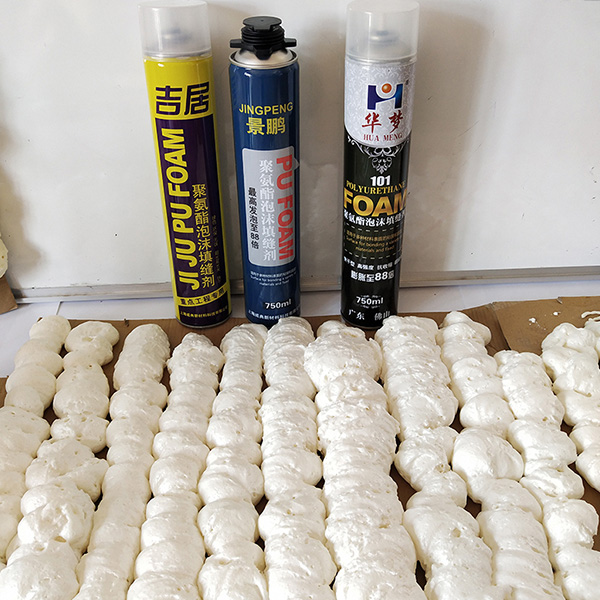| model |
Color |
Minimum order quantity |
Unit weight |
EXW price |
FOB price |
Supply capacity |
Packaging form |
| 700g |
white |
1000 bottles |
700g |
1.8 USD per bottle |
2.4 USD per bottle |
5000 bottles/day |
15 bottles/box |
| 900g |
1000 bottles |
900g |
2.24 USD per bottle |
2.78 USD per bottle |
1. Composition and curing principle
Main components: mainly composed of polyurethane prepolymer, foaming agent, catalyst, foam stabilizer and other components. Polyurethane prepolymer is the core component, which provides the basic polymer structure for the formation of foam. Foaming agents can generate gas under appropriate conditions, causing the material to foam and expand. The catalyst is used to control the speed of foaming reaction, and the foam stabilizer ensures the structural stability of foam during the formation process to avoid the collapse of foam.
Curing principle: when polyurethane foam sealant is extruded from the container, it will contact with moisture in the air. The moisture in the moisture reacts with the isocyanate group in the prepolymer to initiate polymerization, and the gas generated by the foaming agent expands the material to form foam. As the reaction proceeds, the foam gradually solidifies and finally forms a filling material with certain strength and elasticity.
2. Performance characteristics
Good filling performance: polyurethane foam sealant has excellent filling capacity. It can fill various shapes of gaps and voids, whether they are irregular cracks, small holes, or larger gaps, they can be filled by foaming expansion. For example, during the installation of doors and windows, the gaps between the door and window frames and the wall can be well filled to ensure a tight fit.
Excellent thermal insulation performance: foam structure contains a large number of tiny bubbles, which can effectively prevent heat conduction, making it a good thermal insulation material. Using it on the exterior walls, roofs, and other parts of buildings can reduce heat transfer, improve energy efficiency, and reduce the use of air conditioning and heating.
Excellent sealing performance: cured foam has good sealing performance. It can prevent the infiltration of air, water, dust, etc., and is very effective in sealing gaps in places that require waterproofing, moisture resistance, and wind resistance, such as bathrooms, basements, etc. At the same time, it can effectively prevent insects and small animals from entering the room through gaps.
Certain cohesiveness: polyurethane foam sealant will bond with the contact surface during the foaming process. It can bond various building materials such as wood, stone, metal, plastic, etc., enhancing the overall integrity and stability of the filling area.
Elasticity and buffering performance: It has a certain degree of elasticity and buffering performance. This characteristic allows it to play a role in some places that require shock absorption and buffering, such as providing certain buffering protection for pipelines during installation, reducing damage caused by vibration or collision.
Good weather resistance: polyurethane foam sealant with proper formula can adapt to various climatic conditions. Under different temperature and humidity environments, its performance is relatively stable, and it is not prone to aging, cracking, and other phenomena, which can maintain the filling and sealing effect for a long time.
3. Instructions for use
Usage: ① Shake the bottle body for more than 20 seconds before construction, and always keep the bottle mouth facing downwards when gluing. ② Spray a small amount of water on the surface during construction to improve the foaming effect. ③ Do not approach fire sources or expose to sunlight, and do not smoke when applying glue; ④ Store in a cool and dry place, do not invert or lay flat;
4. Usage estimation
900g can spray a volume of about 30-45 cubic decimeters (with a gap of 3-6cm, one can spray for about 30m)
5. Application Fields
Construction industry: It is a commonly used material for building door and window installation, wall gap filling, roof waterproofing and sealing. In home decoration, it can also play a good role in filling gaps between wooden floors, tile gaps, etc.
Pipeline engineering: widely used in filling and sealing gaps between pipelines and walls, and between pipelines. It can provide sealing and buffering protection for pipelines, preventing water leakage and reducing vibration.
Automotive industry: used in automobile manufacturing and maintenance to fill gaps in car bodies, seal car interiors, etc., playing a role in sound insulation, heat insulation, and waterproofing.
Electronic device manufacturing: It also has certain applications in the sealing and filling of electronic device casings, which can prevent dust, moisture, etc. from entering the interior of the device and protect electronic components.






